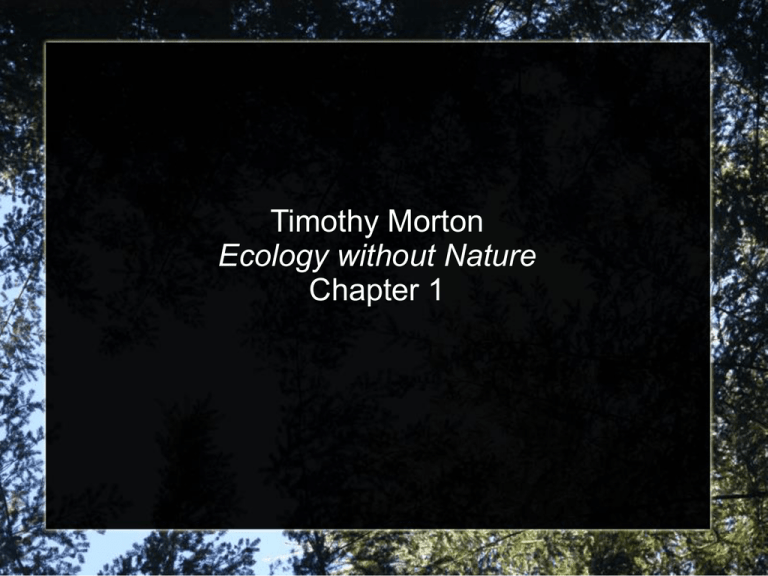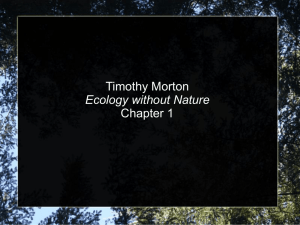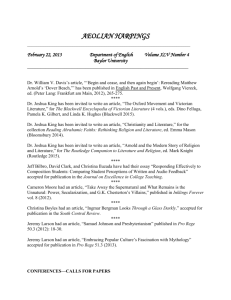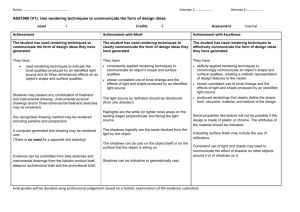Ecology without Nature Presentation
advertisement

Timothy Morton Ecology without Nature Chapter 1 from the Introduction The main theme of the book is given away in its title . Ecology without Nature argues that the very idea of "nature " which so many hold dear will have to wither away in an " ecological" state of human society. Strange as it may sound, the idea of nature is getting in the way of properly ecological forms of culture, philosophy, politics, and art. In the name of ecology, this book is a searching criticism of a term that holds us back from meaningful engagements with what, in essence, nature is all about: things that are not identical to us or our preformed concepts. from Chapter One As I write this, I am sitting on the seashore. The gentle sound of waves lapping against my deck chair coincides with the sound of my fingers typing away at the laptop. Overhead the cry of a gull pierces the twilit sky, conjuring up a sensation of distance. The smoke trail of an ocean liner disappears over the far horizon. The surrounding air is moist and smells of seaweed. The crackle of pebbles on the shore as the waves roll in reminds me of England, summer holidays on stony beaches. The more I try to evoke where I am-the "I" who is writing this text-the more phrases and figures of speech I must employ. I must get involved in a process of writing, the very writing that I am not describing when I evoke the environment in which writing is taking place. The more convincingly I render my surroundings, the more figurative language I end up with. The more I try to show you what lies beyond this page, the more of a page I have. And the more of a fictional "I" I have-splitting "me" into the one who is writing and the one who is being written about-the less convincing I sound. This rhetorical strategy appears with astounding frequency in a variety of ecological texts. In trying to evoke a sense of the reality of nature, many texts suggest, often explicitly, that ( 1 ) this reality is solid, veridical, and independent (notably of the writing process itself) and that (2) it would be better for the reader to experience it directly rather than just read about it. The device-I call it ecomimesis-wants to go beyond the aesthetic dimension altogether. It wants to break out of the normative aesthetic frame, go beyond art. Introducing Walden, Thoreau writes: "When I wrote the following pages . . . I lived alone, in the woods, a mile from any neighbor, in a house which I had built myself, on the shore of Walden Pond, in Concord, Massachusetts, and earned my living by the labor of my hands only." There is nothing more "literary" than this activity of acknowledging, in the negative, the suction of fictional writing. There are six main elements : rendering, the medial, the timbral, the Aeolian, tone, and, most fundamentally, the re-mark. Rendering First and foremost, ambient poetics is a rendering. I mean this in the sense developed by the concrete music composer and cinema theorist Michel Chion. Rendering is technically what visual- and sonic-effects artists do to a film to generate a more or less consistent sense of atmosphere or world. After the action has been shot and the computer and other effects pasted into the film, the entire shot is "rendered," so that all the filmic elements will simulate, say, a sunny day in the Alps, rather than a wet night in the tropics. This rendering, like Jean Baudrillard's idea of the simulacrum, pertains to a copy without an original. There was no "real " sunny day. Rendering nevertheless bathes all the filmic elements in the atmosphere of the sunny day. When ecomimesis renders an environment, it is implicitly saying: "This environment is real; do not think that there is an aesthetic framework here." The Medial The medial derives from the argument in Roman Jakobson's " Closing Statement," with its analyses of phatic statements If we foreground the contact, we obtain a phatic statement (Greek phasis, speech) . " Can you read this awfully small typeface ? " "This telephone line is very crackly. Call me back in five minutes-I can't hear you." " Check, check, check one, microphone check." "Testing,testing." "You're on the air." The contact is the dimension-as literally as you would like to understand that word-in which communication takes place. Phatic statements make us aware of the actual air between us, or the electromagnetic field that makes it possible to listen to recorded music, or see a movie. Medial writing, for instance, highlights the page on which the words were written, or the graphics out of which they were composed. Here comes the twist. One of the media that medial statements can point out is the very medium of the voice or of writing itself. Since the sound of music is available via the medium of, say, a violin, then a medial musical passage would make us aware of the "violin-ness " of the sound-its timbre. The Timbral The timbral is about sound in its physicality, rather than about its symbolic meaning One of the strongest ambient effects is the rendering of this timbral voice. Our own body is one of the uncanniest phenomena we could ever encounter. What is closest to home is also the strangest-the look and sound of our own throat. Thus, timbral statements can be strongly medial, evoking the medium that utters them. The Aeolian The Aeolian ensures that ambient poetics establishes a sense of processes continuing without a subject or an author. The Aeolian has no obvious source. "Acousmatic " sound, for instance, is disembodied sound emanating from an unseen source. acoustic ecology yearns for an organic world of face-toface contact in which the sound of things corresponds to the way they appear to the senses and to a certain concept of the natural. The Aeolian provokes anxiety, because built into it is a hesitation between an obscure source and no source at all. Tone Tone can denote the tension in a string or muscle (muscle tone), or a certain pitch: the way in which matter is vibrating. It also, significantly, refers to a notion of place; hence "ecotone," a zone of ecological transition Tone is useful because it ambiguously refers both to the body and to the environment. For "the body" (as it is so often called in contemporary art and theory) is the environment. Re-mark We generally take one kind of medium to be the background: the ambient air or electromagnetic field, the paper on which text appears. The other kind of medium, the one we explored as the timbral, appears as foreground. A disembodied Aeolian sound emanates "from the background" but appears "in the foreground." With Aeolian events, we have a paradoxical situation in which background and foreground have collapsed in one sense, but persist in another sense. The level of the re-mark is a fundamentally indeterminate one, at which a squiggle could be either just a squiggle or a letter. Rendering appears to dissolve the aesthetic dimension because it depends upon a certain necessarily finite play with the remark. The more extreme the play, the more art collapses into non-art. Hence the infamous stories of janitors clearing away installations, thinking they were just random piles of paintbrushes and pots of paint. There is a politics to this aesthetics. It says that if we point out where the waste goes, we won't be able to keep ourselves from taking greater care of our world The problem comes when we start to think that there is something behind or beyond or above (in other words, outside !) the inside-outside distinction. Not that the distinction is real; it is entirely spurious. Thus, it is wrong to claim that there is something more real beyond inside and outside, whether that thing is a world of (sacred) nature, (traditional ecological language) or machines (Deleuze and Guattari’s world). Yet it is equally wrong to say that there is nothing, to " believe in nothing," as it were, and to say that he or she who has the best argument is the right one-pure nihilism. There is not even nothing beyond inside and outside. Getting used to that could take a lifetime, or more. A work that aspires, however humbly, to the condition of art should carry its justification in every line. And art itself may be defined as a single-minded attempt to render the highest kind of justice to the visible universe, by bringing to light the truth, manifold and one, underlying its every aspect. It is an attempt to find in its forms, in its colours, in its light, in its shadows, in the aspects of matter and in the facts of life, what of each is fundamental, what is enduring and essential — their one illuminating and convincing quality — the very truth of their existence. - Joseph Conrad, Preface to Nigger of the Narcissus My task which I am trying to achieve is, by the power of the written word, to make you hear, to make you feel — it is, before all, to make you see. That — and no more, and it is everything. If I succeed, you shall find there according to your deserts: encouragement, consolation, fear, charm — all you demand; and, perhaps, also that glimpse of truth for which you have forgotten to ask. - Conrad, Preface







